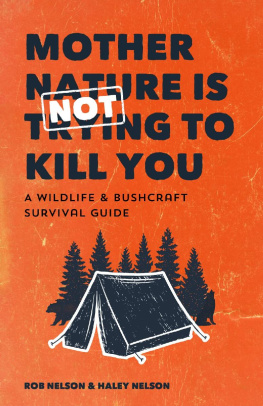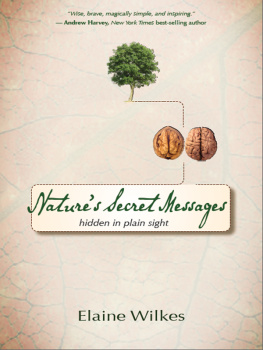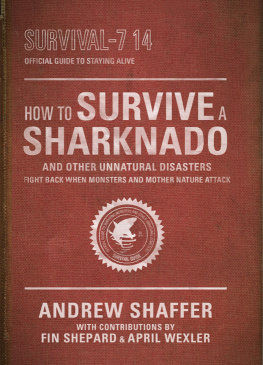Thank you for downloading this Touchstone eBook.
Join our mailing list and get updates on new releases, deals, bonus content and other great books from Touchstone and Simon & Schuster.
C LICK H ERE T O S IGN U P
or visit us online to sign up at
eBookNews.SimonandSchuster.com
CONTENTS
To Shelby

INTRODUCTION
Georgia on My Mind
It wasnt that it hurt all that much. In fact, most of the time I didnt feel anything at all. But once in a while Id get a sharp pinch, almost like someone was pressing the edge of a spoon into the top of my head. I didnt feel sick, and I knew this thing wasnt going to do any permanent damage, but it was driving me nuts: a small, white, pasty maggot with rings of black bristles around its body was lodged firmly into the top of my head. For all my squeezing, I hadnt been able to pop it out. It was only a few millimeters long now, but it was eating my flesh, and I knew it would get much, much bigger in the next few weeks. For the life of me, I had no idea how I was going to get it out.
Id gotten it by accident (obviously) a few weeks prior, working in Belize as part of a team studying bats there. Bats are my thing. Ive always loved bats and by studying them Ive been able to travel all over the world: Ive been to Australia, New Zealand, Madagascar, South Africa, Costa Rica, all over North America, and even to the Amazon rainforest of Ecuador, all just to see bats. The excursion to Belize was early in my career, before most of those other trips, and looking back, I see now that I still had a lot to learn about the natural world.
Belize is a small Central American country, about the size of New Jersey, but whereas New Jersey has nine species of bats, Belize has fifty. Thats why I was there. It was 1998, and I was in the first year of graduate school. Our team wanted to find out where some of those Belizean bats hide during the day, and it was a great opportunity for me to get some experience identifying species Id never seen. After reading countless books and papers about bats, this was my chance to get out and meet some of them.
The place where we worked in Belize is called Lamanai. Its famous for its ancient Mayan ruins, but we were there for the lush rainforest those ruins are buried beneath. The wildlife in Lamanai blew my mind. There were big, colorful toucans, six-foot crocodiles, brightly colored venomous snakes, howler monkeys, about a zillion kinds of gorgeous insects, and of course, bats! Fishing bats, vampire bats, yellow-shouldered fruit bats, sac-winged bats, sword-nosed bats, frog-eating bats... Trust me, if youve got even a passing curiosity about bats, Belize is heaven.
It was a two-week trip, and we were pretty much constantly bushwhacking, so its impossible to guess exactly when I got the botfly. Each night wed set up nets to catch bats; then wed put radio transmitters on some of them. A transmitter is about the size of a coffee bean with a five-inch antenna hanging from it. You glue it to the fur on a bats back, then let the bat go. The transmitter emits a beeping noise on a specific radio frequency, and you can tune in with a radio receiver to find out where the bat is hiding.
Once a radio-tagged bat is released, you can only pick up its signal if youre near the bat, or if you have a clear line of sight between the hidden bat and the antenna in your hand. So each day, wed climb to the top of an ancient Mayan ruin and scan for bats above the forest canopy. Once we got a signal, a beeping from the north, for example, we went out with a machete and cut a trail northward until we picked up the signal again from within the forest. Then we hacked away through branches and vines, following the signal as it got stronger, until we could finally see our bat roosting on a branch, or at least figure out which tree hole our bat was hiding in. It was tricky because we needed to cut a path in front of ourselves with machetes, but we had to be quiet so as not to scare the bats off as we approached. It was also tricky because most of the vegetation we were hacking through was full of nasty things like scorpions, thorny acacia plants covered in ants, and venomous snakes. But, man, I have never had so much fun in my life. By the end of the trip, I was feeling pure bliss. I was sunburnt and covered in bug bites, but Id found a career path that excited me, and I was starting to imagine filling the rest of my life with adventures like this one. Unfortunately, in all the excitement I just failed to notice that one of my insect bites had a maggot in it.
The human botfly looks like a normal housefly, but it is far more stomach-churning than the thing that keeps landing on An adult female botfly zips around in the rainforest, then catches a mosquito in the air, lays an egg on her abdomen, and lets her go. Later, the mosquito bites a mammal (a monkey, a jaguar, or a bat biologist, for example), and while that mosquito feeds, the botflys egg falls off the mosquito and onto that mammal. The egg hatches into a maggot, which makes its way into the hole created by the mosquito and then settles in to feed and grow. The maggot starts out just a few millimeters long but grows steadily, until after a month and a half or so, when the maggotnow about an inch longeats its way back out of the skin, falls to the ground, molts into an adult fly, and then flies away.
Its actually a pretty smart strategy by the botfly. The adult is big enough that if Id seen one land on me, Id have slapped it silly. But the adult never came anywhere near me. It used a mosquito as its courier service, so I didnt even notice. In fact, I didnt realize anything was wrong until I was home a few weeks later.
The maggot was firmly lodged at the top of the back of my head, just on the right side. At first it was like any mosquito bite, but a bump started forming around the bite, and that bump was steadily growing. That spot is a very hard place to look at closely on your own head. I tried with two mirrors and a flashlight, but I just couldnt get a good lookit was too hard to part my hair and squeeze with all that stuff in my hands. All I could see was a swollen red area about the size of a dime. In the center of the red zone was a tiny hole, and sometimes other people would tell me they could see a little white snorkel come poking out of that hole. That was how I knew for sure what I had, because that snorkel is how botfly maggots get their oxygen.
This did not impress my friends in the slightest. They made me wear a hat, and if I so much as scratched my face, theyd immediately make me go wash my hands. I tried to explain to them that they couldnt catch a botfly from me, but that didnt seem to matter. As far as they were concerned, I had cooties.
After a couple of days, they felt comfortable enough to start making fun of me, but they still wouldnt come very close. Their jokes were marvelous. They told me the whole botfly thing was just in my head. They told me they knew it was tough but that I shouldnt let the botfly get under my skin. And they also wanted to know if I could claim my botfly as a dependent on my taxes. They even gave her a name.
Georgia.
So it went, for about a week. I went about my business, with Georgia on my mind, squeezing to try to get her out now and then but mostly just hoping shed somehow go away. Botflies are hard to squeeze out because they have sharp backward-pointing bristles around their bodies that brace them firmly in the flesh. If theyre lodged somewhere like your arm or chest, you can squeeze enough skin to get behind them and pop them out of that breathing hole, but other parts of the body dont let you get underneath it. On my head, I just couldnt get the leverage I needed, so Id end up squeezing Georgia on the sides, and then she would just hurt more. I hoped that once she got bigger, Id be able to get my fingers underneath her to squeeze her out, but that strategy never seemed to work.













